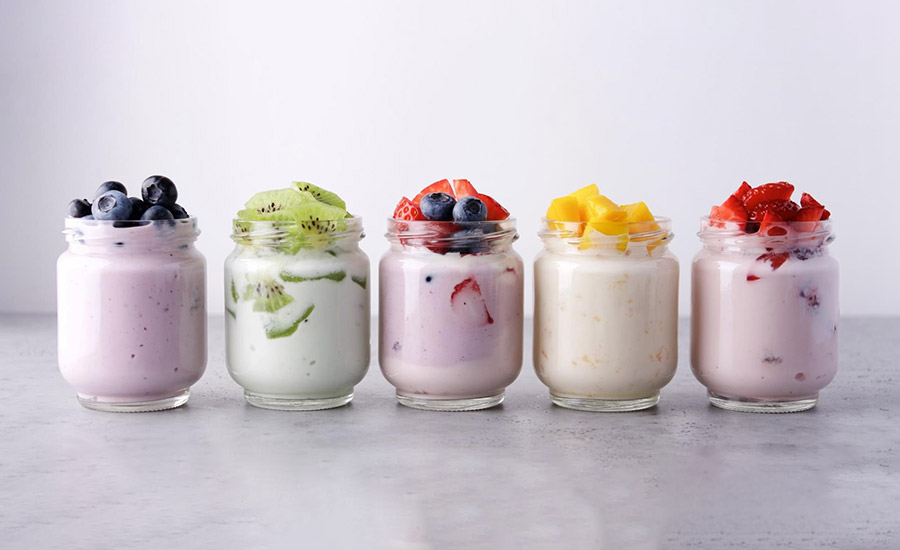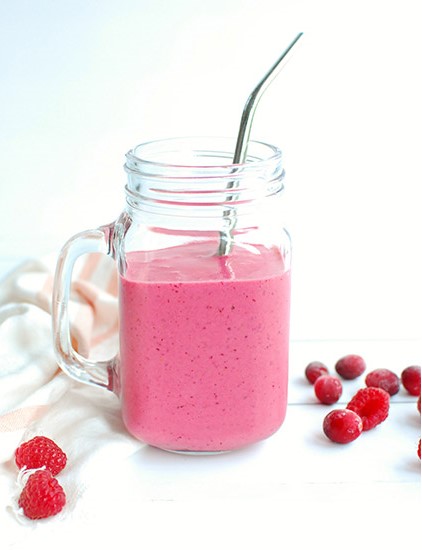Dairy processors are becoming increasingly adventurous.
In response to the growing consumer demand for selections that are new, exciting, and healthy, more processors are incorporating a wider array of inclusions in their selections, with fruit and nuts playing key roles.
Fruit and nuts are forecast to have the highest inclusion growth rate through 2027, reports Markets and Markets, a Hadapsar, India-based research firm. “The significant growth of fruit and nut inclusions can be attributed to consumer demand for fruit and nut ingredients, their flavor popularity, and perceived health aspects associated with their content,” the firm states.
“Inclusions used to be the sidekicks of dairy products, but now they’re stealing the spotlight,” adds Heidi Clark, national sales and marketing manager at MicroDried, a Nampa, Idaho-based provider of fruit and vegetable ingredients.
The incorporation of dairy inclusions is becoming increasingly attractive because of the taste, texture, antioxidants, vitamins, and omega-3 fatty acids that the ingredients are adding to products, she states. “It’s not just about flavor anymore; it’s about making a wellness statement, earning loyalty, and standing out in the market,” Clark notes.
Indeed, she says that a growing base of health-conscious consumers are seeking products that taste great and contribute to their physical condition. “Processors are responding to this trend by incorporating functional ingredients, such as fruit and nuts, which bring added value to dairy products,” Clark states. “Consumers aren’t just snacking; they want snacks and meals that double as superheroes for their well-being.”
Enhancing the eating experience, which includes upgrades to nutrition and taste, is vital because fewer consumers are associating health with deprivation, says Lisa Jackson, director of marketing for FlavorSum LLC, a Kalamazoo, Mich.-based flavor provider. “The shift creates opportunities for dairy processors to offer inclusions that address a range of needs, from indulgence — full or permissible — to functional benefits or comfort,” she notes.
Shopper interest in health and wellness, meanwhile, continues to expand, Jackson states. FlavorSum research reveals that boosts to immune health tops the list of sought-after health benefits. Next are ingredients that help with cognitive function, energy, digestive health, bone support, weight management, and heart health. “Inclusions with ‘extras’ beyond taste or texture will attract attention,” she says.

Inclusions that are free from artificial flavors, colors, sweeteners, gluten, soy, and bioengineered ingredients are also gaining popularity, says An Ho, director of food science and product innovation for IFPC, a Fenton, Mo.-based ingredient supplier. “If the overall product, be it ice cream or cultured dairy, is making a claim or meeting a specific type of diet, then the inclusion needs to meet the label claims,” Ho states.
A range of expectations
Identifying the optimal inclusions to include with dairy selections, however, can be complex, Jackson says, noting that processors “need to assess whether the inclusions align with dairy customers’ current wants and needs.”
While blueberries, for instance, link with heart health and cognitive functions, they are not as “buzzy” as the more novel and equally beneficial huckleberry, she notes.
It is important, however, that processors meet the growing shopper interest in newer flavors that “teases the new palates and interests of the more seasoned consumers,” says James Bruce, executive vice president of sales for Pecan Deluxe Candy Co., a Dallas-based inclusions provider.
While Gen X and baby boomers tend to prefer familiar items, Gen Alpha, Gen Z, and millennials are seeking fresh ideas in the frozen dairy section, he states.
“Gen Z and Gen Alpha are predisposed to accept change easily and love inclusivity,” Bruce explains. “They will seek out cool and eclectic flavors to be the first to share an Instagram story to their groups. Manufacturers that do not tap into this trend will be left behind.”
A move away from full meals to snacking is further spurring consumer interest in the latest inclusions, he adds. “We need items with immediate flavor impact and ease of functional use,” Bruce states. “Dairy processors should be less concerned about price and more concerned about flavor, especially as portion size shrinks. Today’s consumer will pay for perceived luxury and unique experiences.”
Indeed, some manufacturers are looking to produce inclusions and products that meet the expectations of a local bakery or kitchen, says Kami Smith, Pecan Deluxe’s director of culinary showcasing. “They want to see the cracks, the extra dustings of flour, the not-so-perfect cuts on brownies, the hand-bent candy canes, and the beautifully iced cakes ‘made with love in the bakeshop,’” she states.
In addition, indulgent inclusions are increasingly mimicking desserts, Ho notes. “Any exotic fruit can spice up an ice cream outside of the standard raisin, banana, or various berries,” she says, which can include coconut flakes, candied kiwi, mango chunks or lychee.
“With the frozen desserts segment experiencing generally strong growth, brands have the opportunity to push the boundaries and create exciting new flavors to grow their market share,” a whitepaper from Parker Products, a Fort Worth-based ingredients supplier, reports.
Cranberries are among the inclusions that are becoming more prominent in dairy recipes, says Karen Cahill, marketing director for the West Wareham, Mass.-based Cranberry Marketing Committee. Cranberries are popular ingredient options for smoothies and yogurts, and, because the fruit freezes well, are also a good fit for ice cream, she states.
“Fresh fruit is only available from about September through January, so frozen cranberries, which are available year-round, are an excellent substitution for fresh,” according to Cahill.
Going nuts for some crunch
Along with fruits, nuts, which give a “great toothsome bite to ice cream and yogurts,” are becoming more attractive inclusion options, Ho says. She states that varieties are expanding to include candied, spiced (both sweet and savory), brittle forms, and flavor coverings, such as vanilla, strawberry, and chocolate.
Walnuts, too, are among the inclusions that can elevate flavor, texture, and the nutritional value of dairy selections, says Jennifer Olmstead, senior director of U.S. marketing and communications for the Folsom-based California Walnut Board and Commission.

She notes that the mild umami flavor pairs well with a wide range of ingredients, including bananas, strawberries, cranberries, honey, dark chocolate, and wasabi, and that the walnut’s crunch complements a softer mouthfeel.
“This is essential in ice creams and yogurts where product developers want a crunch, but not a hard bite,” Olmstead explains. “There also is a trend toward softer foods to accommodate an aging population.”
Ice cream, yogurt, cheese, and cream cheese are among the dairy items that can best incorporate walnut inclusions, she states, noting that walnuts can add nutrition to an indulgent product without detracting from flavor or texture. “Some flavors, like maple walnut, also appeal to the trend for nostalgic flavors,” Olmstead says.
In addition, walnuts have a tannic quality that can pair with rustic cheeses and is a familiar flavor to incorporate with pungent cheeses, she adds.
Merchandisers of products with walnuts, however, must fight what Olmstead says is the erroneous perception that tree nuts don’t have as long of a shelf life in shelf-stable products. Yet, since most dairy products require cold storage, “that should help negate concerns.”
To leverage the most pertinent inclusions, Bruce says dairy processors should partner with innovative suppliers that utilize dynamic marketing and research and development teams. Among the newer inclusions making headway in ice cream and yogurt are jelly boba, mochi-like alternatives, and fresh spins on cookies ’n cream.
“In addition, items such as confectionary coated popping candy and sprinkles are adding texture and interest among the most successful brands,” he states.
Prepare for problems
Availability and the price of ingredients can be obstacles for processors seeking to enhance their use of inclusions, IFPC’s Ho says, adding that creating tasty products that consumers will repeat purchase can be difficult too.

“The combination of ingredients also might not interact together as planned, so shelf life could be a problem,” she notes. “If the end formula that ensures all the demands seems good, sensory testing or focus panels can see if the product is sound in taste, texture and color, and processors should execute proper shelf-life testing,” Ho says.
Developers also should ensure that their inclusion choices fit with their brand’s identity, goals, and customer perceptions, FlavorSum’s Jackson says. A value-driven ice cream brand, for instance, will likely have trouble marketing a product with macadamia nuts, she states. “The cost may push the price point above the customer’s willingness to pay,” Jackson notes.
In addition, processors may face greater development times as they source trending ingredients and pilot test new variegates such as inclusions with diverse types of fruits or nuts, she notes.
To help manage these challenges, processors can team with insights providers and supplier partners to identify ideas and capitalize on favorable trends while evaluating the marketing, procurement, and production processes with internal teams, Jackson says.
“If time and budget permit, screening concepts or benchtop samples with brand buyers also will give processors important feedback that can reduce the risk of poor in-market performance,” she states.
Moving forward, processors will likely face greater scrutiny of the healthiness of inclusions as consumers become more knowledgeable about the nutritional effects of ingredients.
“Consumers have technology at their fingertips and are able to look up anything at any time, which educates them on the benefits or adverse effects of ingredients,” says Tara Gonzales, Pecan Deluxe’s director of marketing.
Sustainability also will play a greater role in purchasing decisions, Jackson concludes. “Processors using inclusions may need to monitor consumer sentiment about the environmental impacts of producing or sourcing the inclusions, such as water and energy consumption.”


